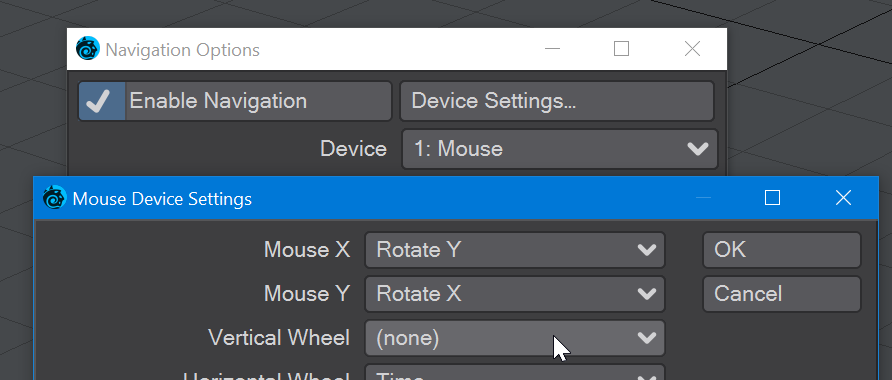Navigation Options
Introduction
The Preferences window for using 3D mice and other HID (Human Interface Device) controllers with LightWave can be found in Edit > Navigation Options. 2019.1 has added keyboard and mouse-based gaming methods in addition to specialized CAD equipment for use in Layout and Modeler.
Note a change in the Navigation Options panel compared to previous: the Name/Enable/Reverse/Sensitivity/Scale settings columns are now per-device instead of global. Also, the System Panel button is now the Device Settings button, and one of the Enable Navigation buttons is now named Enable Device.
Controls
To enable the new navigation options, press X while in the main Layout or Modeler window. You will see a message appear at the top of the viewport or viewports indicating which Navigation mode is being used. In this new navigation mode, the traditional game keys of W, A, S, and D move in the X and Z directions with Shift speeding movement and Ctrl slowing it down. E and Q move in the Y-axis, while mouse movement controls rotation around Y and X axes. The vertical scroll wheel controls the field of view, while in Layout, the horizontal scroll wheel controls the scene playhead.
Device Settings
Below the Device Settings button is a dropdown list of devices to choose amongst. There will usually be at least Device 0: Keyboard and Device 1: Mouse but you may have additional 3D pointers, etc. For the keyboard and mouse, clicking the Device Settings button will bring up one of two panels:
Keyboard and Mouse settings
Clicking the buttons in the keyboard settings window will permit changing the keys used for the actions described on the buttons, and the mouse settings cover mouse down and up functions and support up to two additional buttons.
By default, the vertical scroll wheel controls the field of view in both Modeler and Layout in the new navigation options. While it is easy to reset Modeler's default 500 just by opening the Modeler Display Options (D) and tapping in the Perspective Amount field, there is no such setting in Layout. It is suggested that you disable the vertical scroll wheel setting for the mouse in Device Settings in the Navigation Options... panel.
(If you have already scrolled the wheel before disabling this setting and want to recover your zoom manually without restarting Layout, exit the new navigation mode by hitting X. Select an item in Layout, hold down Ctrl and Alt and move the LMB. In the X field at the lower left of Layout you will see a number. 4 is the normal field of view. If the number you have is greater than four, then hit X again and roll the scroll wheel backward. If less than four, X and scroll forwards. Check that you haven't overshot.
<4 scroll forward. >4 scroll back
Subjects and Styles
There are several Subjects and Styles:
- View - Acts like using the Viewport navigation controls. If the view is a camera or light, you will be controlling the camera or light in the scene.
- Grab - This attempts to emulate grabbing the world as you see it.
- Orbit - This is similar to grab but using a point of interest in front of the viewer that it will rotate about.
- Helicopter - This attempts to emulate flying a helicopter
- Walk - similar to helicopter but with limits on the pitch and bank. It attempts to emulate walking.
- Current Item - Moves and rotates the currently-selected object.
- Grab - This emulates grabbing the item relative to what the viewer sees.
- Helicopter - This emulates flying the item from the point of view of the item (as if the user were inside the item flying it like a helicopter).
- Timeline - A mode that uses the Twist on a Space Explorer or equivalent to act like a jog/shuttle dial on a video control surface. Holding the Alt key while rotating the device’s puck will result in faster scanning through the timeline. The difference is more noticeable when the scene length is longer - a 120-frame scene is only barely noted, whereas the difference between normal scanning and Alt-scanning a 600-frame scene is pronounced. The changes for 2019.1 mean that this separate Subject is not as needed as a horizontal scroll wheel can move through the timeline while in the View or Current Item subjects.
Presets
You can create presets for settings to be able to quickly store and retrieve settings for different devices. References to a puck’s X, Y and Z axes consider the navigation device to be laying flat on a table and the x-axis being to the right, the y-axis being upward, and the z-axis being forward away from the user. The Sensitivity and Scaling can be controlled for individual channels for your external control device. You can stop specific channels from being evaluated completely if you choose by unchecking the channel concerned, or reverse a channel’s direction.





